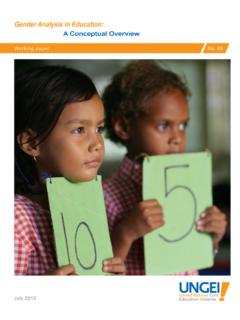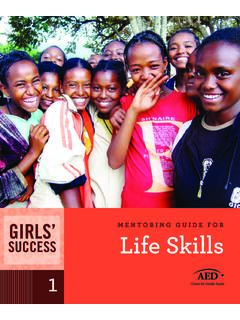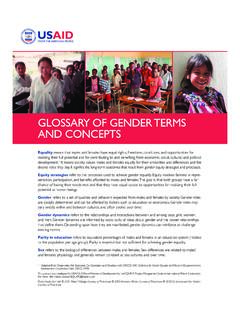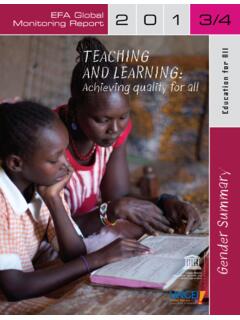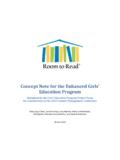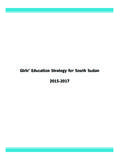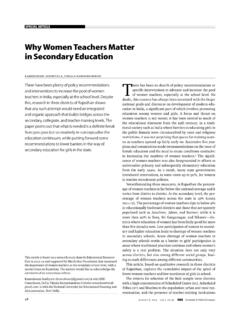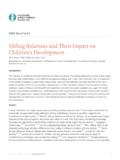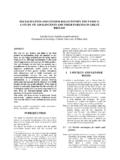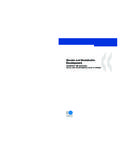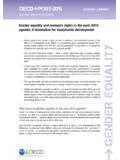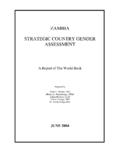Transcription of Education from a Gender Equality Perspective - with …
1 Education FROM A Gender . Equality Perspective . MAY 2008. This report was developed for USAID's Office of Women in development by the EQUATE Project, Management Systems International (Prime Contractor). This report was developed for USAID's Office of Women in development by the EQUATE. Project, Management Systems International (Prime Contractor). This report was contracted under GEW-I-00-02-00021-00, Task Order #1, EQUATE: Achieving Equality in Education . Cover photos: Top left: Children at a school in Kazakhstan participate in a national reading day.
2 Sapargul Mirseitova/ Kazakh Reading Association, Courtesy of USAID. Top right: Young students in India look on as their teacher uses a chalkboard to explain a lesson. 2007 Rabin Chakrabarti, Courtesy of Photoshare Bottom right: A girl in Guatemala waits for her mother after school. 2003 Antonieta Martin, Courtesy of Photoshare Bottom middle: Boys in Egypt reading books provided through USAID-funded educational programs. Ben Barber, Courtesy of USAID. Bottom left: A young girl in Eritrea works on her studies. 2006 Konjit B. Ghebremariam, Courtesy of Photoshare Education FROM A Gender .
3 Equality Perspective . DISCLAIMER. The author's views expressed in this report do not necessarily reflect the views of the United States Agency for International development or the United States Government. CONTENTS. EXECUTIVE SUMMARY .. 1. THE development CHALLENGE .. 1. Girls' Education at a 3. WHAT ABOUT BOYS?.. 4. Gender Equality : A CONCEPTUAL FRAMEWORK FOR REACHING. ALL LEARNERS .. 5. THE RELATIONSHIP BETWEEN QUALITY AND 6. THE MULTIPLE DIMENSIONS OF Gender Equality IN Education .. 7. Equality of Access .. 8. Equality in the Learning Process.
4 8. Equality of Educational Outcomes .. 9. Equality of External Results .. 10. 11. CONCLUSION .. 12. 13. EXECUTIVE SUMMARY. Education is universally acknowledged to benefit individuals and promote national development . Educating females and males produces similar increases in their subsequent earnings and expands future opportunities and choices for both boys and girls. However, educating girls produces many additional socio-economic gains that benefit entire societies. These benefits include increased economic productivity, higher family incomes, delayed marriages, reduced fertility rates, and improved health and survival rates for infants and children.
5 Over the years, Education has focused on access and parity that is, closing the enrollment gap between girls and boys while insufficient attention has been paid to retention and achievement or the quality and relevance of Education . Providing a quality, relevant Education leads to improved enrollment and retention, but also helps to ensure that boys and girls are able to fully realize the benefits of Education . The primary focus on girls' access to Education may overlook boys' educational needs. This approach also fails to confront the norms and behaviors that perpetuate inequality.
6 This paper presents a framework that has been designed to address the inequality described above. A tool for Education programmers, the framework helps ensure that Education projects meet the needs of all learners. Using an approach that takes into account the relations and interaction between males and females (also known as Gender dynamics), the Gender Equality Framework addresses four dimensions of Equality in Education . These are: Equality of access, Equality in the learning process, Equality of educational outcomes, and Equality of external results.
7 Sections on each of the four dimensions include concrete activities that can be implemented as part of an overall strategy to achieve Gender Equality in Education . Additional examples are provided through the use of text boxes, which highlight successful USAID Education interventions. In addition to presenting the framework, this report also explores topics such as the relationship between Education quality and Gender Equality and the distinction between parity and equity. Achieving Gender Equality in Education means that boys and girls will have equal opportunities to realize their full human rights and contribute to and benefit from economic, social, cultural, and political development .
8 THE development CHALLENGE. Research has shown that Education is one of the most effective development investments countries and their donor partners can make (Basic Education Coalition 2004). Adequate investments in Education facilitate the achievement of most other development goals and increase the probability that progress will be sustained (USAID 2005). Each year of schooling increases individual output by 4-7 percent, and countries that improve literacy rates by 20-30 percent have seen increases in gross domestic product (GDP) of 8-16 percent (Basic Education Coalition 2004).
9 Education builds the human capital that is needed for economic growth (USAID 2005). It also produces significant improvements in health, nutrition, and life expectancy, and countries with an educated citizenry are more likely to be democratic and politically stable. Educating girls achieves even greater results. When girls go to school, they tend to delay marriage, have fewer but healthier children, and contribute more to family income and national productivity. In fact, educating girls quite possibly yields a higher rate of return than any other investment available in the developing world (Summers 1992).
10 Despite this fact, [i]n 2005 only 59 (about one-third) of 181. countries with data available had achieved Gender parity in their [gross enrolment rates] for both Education FROM A Gender Equality Perspective 1. primary and secondary Education (UNESCO 2007). While disparities in primary and secondary enrolment rates are decreasing, they have not yet been eliminated (UNESCO 2007). Considerable attention has been paid to improving access and quality at the primary level; however, there is some indication that secondary level Education may provide higher returns, especially for girls.
